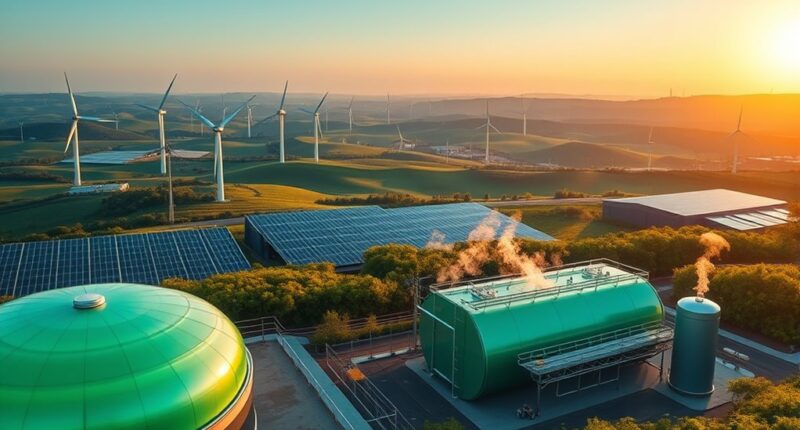Green hydrogen has the potential to power the next energy revolution by replacing fossil fuels in industries, transportation, and grid stability. It’s produced using renewable energy, making it a clean and sustainable option that reduces emissions. As costs decrease and technology advances, green hydrogen could substantially cut greenhouse gases and create new economic opportunities. To understand how this future could unfold and impact your world, keep exploring the possibilities ahead.
Key Takeaways
- Green hydrogen offers a sustainable energy source by utilizing renewable power and producing zero emissions during production.
- It enhances energy system flexibility by storing excess renewable energy for later use.
- Green hydrogen can decarbonize hard-to-electrify sectors like industry, shipping, and aviation.
- Technological advances and decreasing costs are driving broader adoption and investment in green hydrogen.
- Widespread green hydrogen use could significantly reduce greenhouse gases and accelerate the energy transition.

Have you ever wondered how we can produce clean energy without harming the environment? Green hydrogen offers a promising answer. Unlike traditional hydrogen, which is often derived from fossil fuels, green hydrogen is generated using renewable energy sources like wind, solar, or hydropower. This process, called electrolysis, splits water into hydrogen and oxygen without releasing harmful emissions. As a result, green hydrogen becomes a crucial component in reducing overall emissions and combating climate change. It’s not just about creating clean fuel; it’s about transforming how we think about energy storage and utilization. Because renewable energy sources are intermittent—solar power drops at night, wind varies—green hydrogen acts as a form of renewable storage. It allows excess electricity generated during peak times to be stored safely and efficiently, then used when demand is high or renewable generation is low. This flexibility makes green hydrogen an essential part of a sustainable energy system, smoothing out fluctuations and ensuring a continuous supply of clean power. As you explore its potential, you’ll see how this storage capability can help decarbonize sectors that are difficult to electrify directly, like heavy industry, shipping, and aviation. Green hydrogen can replace fossil fuels in these areas, further aiding emission reduction efforts. Governments and private companies are investing heavily in green hydrogen projects, recognizing its potential to reshape energy markets and reduce reliance on polluting fuels. Its versatility means it can serve as a clean alternative for heating, transportation, and industrial processes, making it a cornerstone of the next energy revolution. For you, this means a future where energy is both abundant and environmentally friendly. As green hydrogen becomes more widespread, the costs are expected to decrease, driven by technological advancements and increased renewable capacity. This downward trend will make green hydrogen more accessible and economically viable, encouraging broader adoption across various sectors. The shift to green hydrogen also supports global climate goals, helping nations meet their emission reduction targets while promoting energy independence. By harnessing renewable sources to produce hydrogen, you’re participating in a cycle of sustainable development that benefits the planet and future generations. Increasing investment in renewable energy capacity will further enhance green hydrogen production and its benefits. The widespread use of green hydrogen could greatly cut greenhouse gases, improve air quality, and create new economic opportunities. All of this underscores its potential to power the next energy revolution, making clean, renewable energy more practical and widespread. As you consider the future, remember that green hydrogen isn’t just a fuel—it’s a bridge toward a cleaner, more resilient energy system. Its ability to store renewable energy and reduce emissions makes it a game-changer in the fight against climate change. The path ahead is promising, and with continued innovation and investment, green hydrogen can help you and the world embrace a sustainable energy future.
Frequently Asked Questions
What Are the Main Challenges in Scaling Green Hydrogen Production?
You face several challenges in scaling green hydrogen production. Storage solutions are critical, as hydrogen needs safe, efficient ways to be stored and transported. Additionally, policy incentives are essential to support infrastructure development and reduce costs. Without strong government policies and investments, scaling efforts will slow down. Overcoming these hurdles requires coordinated efforts to improve storage technology and create supportive regulations, ensuring green hydrogen can meet future energy demands effectively.
How Does Green Hydrogen Compare Cost-Wise to Fossil Fuels?
They say “you get what you pay for,” but green hydrogen is increasingly competitive with fossil fuels in cost comparison. Although initial costs are higher, advancements and economies of scale boost its economic viability. Over time, green hydrogen could become more affordable, making it a smarter choice for sustainable energy. In the long run, investing in green hydrogen might just pay off, especially as fossil fuel prices fluctuate.
What Infrastructure Is Needed to Support Green Hydrogen Use?
You need robust storage infrastructure and efficient transportation networks to support green hydrogen use. Storage options like pressurized tanks or underground facilities guarantee safe, reliable supply, while transportation networks—pipelines or specialized carriers—allow you to move hydrogen effectively. Investing in these infrastructures is essential for scaling up green hydrogen, making it accessible across regions, and integrating it into existing energy systems for a sustainable future.
Are There Environmental Concerns Associated With Green Hydrogen?
Coincidence often makes you wonder about the environmental impact of green hydrogen. You might think it’s entirely eco-friendly, but resource sustainability remains a concern. Producing green hydrogen requires significant renewable energy and water, which could strain resources if scaled rapidly. While it offers a cleaner alternative, you should consider potential environmental effects like water use and land impact, ensuring that its green promise doesn’t come at unintended ecological costs.
Which Industries Will Benefit Most From Adopting Green Hydrogen?
You’ll find that industries like steel, chemicals, and transportation benefit most from adopting green hydrogen. It plays a key role in industrial decarbonization and renewable integration, helping reduce emissions and reliance on fossil fuels. By switching to green hydrogen, you can lower environmental impact, improve sustainability, and meet stricter regulations. These sectors stand to gain significant cost savings and cleaner operations, making green hydrogen a crucial part of their future energy strategies.
Conclusion
Green hydrogen could be the spark that ignites a new era of clean energy, transforming our world like a mighty engine powering progress. By investing in this renewable resource, you become part of the solution, steering us toward a sustainable future. Embrace the potential of green hydrogen now, because waiting on the sidelines is like watching a storm approach without shelter. The time to act is now—your choices can fuel the next energy revolution.










